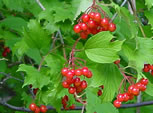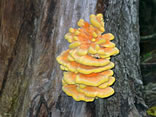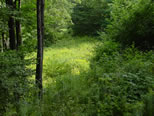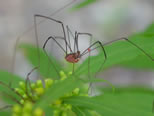
Nature Journal
| |
|||
| Sunday, September 22, 2002 | |||
 This
is a highbush cranberry (viburnum) bush that I see on one of my usual
walks. Its fruit is the preferred food of ruffed
grouse and cedar waxwings, but
is also eaten by many other birds. This
is a highbush cranberry (viburnum) bush that I see on one of my usual
walks. Its fruit is the preferred food of ruffed
grouse and cedar waxwings, but
is also eaten by many other birds. What puzzles me about this particular bush is that the birds don't seem to touch it. The fruit stays on it long into the winter. There used to be another highbush cranberry about 20 feet away - until it was cut down along with some other brush. Each year, THAT bush would be picked clean by the birds during the fall. Hmmm... Now that the other bush is gone, maybe the birds will go after this one?? |
|||
| Saturday, September 21, 2002 | |||
| Haven't
heard any warblers in a while. But when I woke up this morning, I heard a black-throated green warbler singing outside my window. It just sang its song a couple of times and then was gone. Must be on its way south with the rest of the migrating birds. |
|||
| Friday, September 20, 2002 | |||
 This
mushroom, Sulphur Polypore, breaks down the cellulose of dead trees. This
mushroom, Sulphur Polypore, breaks down the cellulose of dead trees.Also called Chicken of the Woods, it is a fairly common mushroom in New England. As it ages, it becomes paler and paler, until it finally becomes |
|||
| white. | Click to enlarge | ||
| Thursday, September 19, 2002 | |||
| Here's
an interesting web page about bird
migration. Explains about the classification of birds as permanent
residents, summer residents, winter residents, and transients. Tells
about why birds migrate and how they prepare. Also has a map showing the flyways of migratory birds. |
|||
| Wednesday, September 18, 2002 | |||
 This
is a photo of the clearing below my house. The yellowish glow is from
sunlight hitting the goldenrod. I often see the whitetail
deer in this clearing - at all times of the year. This
is a photo of the clearing below my house. The yellowish glow is from
sunlight hitting the goldenrod. I often see the whitetail
deer in this clearing - at all times of the year.In the early summer, I saw my "local" whitetail doe at the far edge of this |
|||
| clearing. She was licking her rump and | Click to enlarge | ||
|
kept raising her tail. These are signs that a doe is going to give birth soon. Several weeks later, I saw the bedding spots in the clearing where she had been hiding her fawn(s). The whitetail doe only visits her newborn fawns a few times each day - to nurse them and move them to a new location. The fawns don't bed together until they are three or four weeks old. This helps protect them from predators. |
|||
| Tuesday, September 17, 2002 | |||
| Have
been hearing the blue jays a lot lately.
As is true with other birds, they become more vocal once the nesting
season is over. Also hearing the northern
flicker, especially in the mornings. And the black-capped chickadee is now singing its "chicka-dee-dee-dee-dee" song most of the time. In the spring and summer, its "fee-bee" song (first note higher than second) is more commonly heard. |
|||
| Monday, September 16, 2002 | |||
 Here's
a photo of a female daddy-long-legs. I found the male
and female on a goldenrod plant. Here's
a photo of a female daddy-long-legs. I found the male
and female on a goldenrod plant.This daddy-long-legs is not a true spider. True spiders have two body parts (head and abdomen) and produce silk. |
|||
| Click to enlarge | |||
| Top of page | |||
|
|
| Birds | &n |